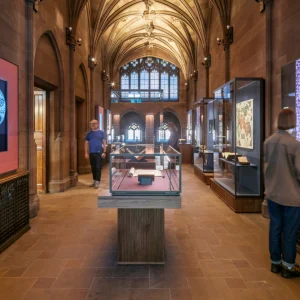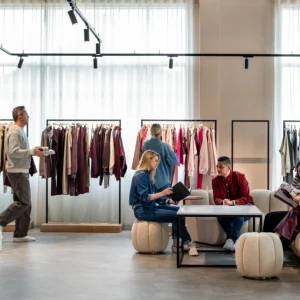
Words: Veronica Simpson
Portrait: Ivan Jones
A conversation with Paul Smith is a rollercoaster ride of an experience. Once this lanky, likeable gent starts talking on one of his favourite topics — and there are many — it’s hard to stop him. The man is as chock-full of anecdotes and insights and little gems of delicious, celebrity-studded experiences as his now legendary office is full of lush paintings, rare art and design books and little knick-knacks that have been sent to him from all over the world by his many legions of fans.

The latest Paul Smith shop, which opened in Albemarle Street, London in September
On this mild autumn morning Blueprint is here to talk about his show at the Design Museum, but he’d rather talk about his new Albemarle Street shop. An extension of his first furnishings shop, it is filled with interesting antiques (sourced by his long-serving man with the ‘eye’ for objets d’art, Nick Chandon) and a carefully edited selection of clothes. It is currently hosting an exhibition of Dieter Rams’ early designs (all for sale), while the shoe room is lined with 26,000 dominoes, unfolding across the walls like tactile, abstract wallpaper. He loves the dominoes, and the fascia covered in cast iron hoops, woven painstakingly together by 6A architects who masterminded the extension. ‘There’s such lovely details everywhere,’ he enthuses. Indeed it was, as 6A architects’ Tom Emerson recalls, the cast iron that sealed the deal when the practice pitched its scheme: ‘I mentioned that cast iron was one of the most important elements in London’s urban fabric, after brick. All the railings, drain covers, lamp posts: it’s everywhere. When I talked about revealing this hidden element his eyes lit up, and he said: "That’s what I do!"’

Cast iron detail from the Albemarle Street store
Despite his small army of designers, he’s in on every decision, weighing up the commercial and aesthetic pros and cons behind each move. With Albemarle Street, for example, after his interest was pricked by the cast iron, Tom Emerson says: ‘His next question was: "Have you worked with it before?" And we said: "Yes, at Raven Row." Then he wanted to know which foundry we’d use. We also know that he went to Raven Row to check it out.’

Smith believes it’s the real attention to detail that makes his products stand out from the crowd
Expressing character through shop design was drummed into the Paul Smith DNA early on, with his first London shop on Floral Street — though not the one we know today. It was at number 44, where he introduced ‘minimalism before minimalism had been invented’, he says. Designed in collaboration with sculptor Peter Wigglesworth, it was ‘completely pure: concrete floor, white walls, black rails’. What was the idea behind the minimalism? He says: ‘I was in love with Bauhaus and Le Corbusier — like a pathetic child I used to carry a book on Bauhaus everywhere. I loved that it was so opposite to everything I ever knew about. I liked the simplicity.’

The Paul Smith shop in LA; and below the unexpectedly traditional interior of the same store
Smith is all about hard graft, so where’s the self-indulgence? One element is allowing his design team free rein to think up crazy but wonderful moments in the shops, such as Albemarle Street’s domino wall; it means adding an extra art gallery in so he can show off his favourite designers (Rams) or artists of the moment (Craigie Aitchison, Martin Parr) in Beijing, South Korea, Tokyo. But the biggest self-indulgence is probably allowing himself not to spend too much time on planet fashion. He says: ‘It’s not a world that has any reality attached to it. It’s such a big facade. But we’re independent. I’m the boss. I’m just a normal bloke who just gets on with it. Pauline and I have been together since I was 21. I have stability at home. We don’t go to private views. We might go to see an exhibition but quietly when there’s not a lot of people around. Private views are normally about something else — about looking over your shoulder and seeing who’s being photographed.’ He laughs: ‘It’s a miracle we’re still in business.’

He would much rather spend time with his famous cyclist, designer and architect friends, talking bike weights and buildings. He’ll spend an hour with Jonathan Ive when he’s in town — and allow him to browse his extensive design library. He thinks it’s hilarious that he was asked to give a talk to Apple employees recently, ‘because I don’t own a computer’. But he’s far from a technophobe. ‘I have 70,000 followers on Instagram,’ he gleefully relates. ‘I take the pictures and do one sentence then I send them to Sean (his IT genius). What’s interesting is how many responses we get — between 1,500 to 5,000 to every photograph straight away. That’s probably because it’s never about fashion. Smith’s real secret is the genuine enthusiasm and passion for the whole crazy circus he appears to be in charge of. That — in any business — is priceless.
To read the full, unedited version of this article in which Paul Smith talks about his approach to the design of his stores and the secret of his ‘recession-proof’ style of design, subscribe to Blueprint here.





